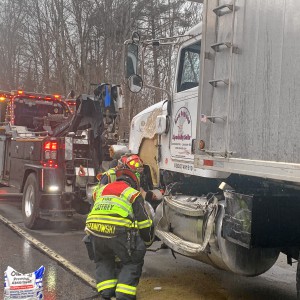BUSINESS QUARTERLY: Challenges and opportunities at independent schools
| Published: 10-17-2023 9:00 AM |
TJ Mackey, head of The Well School in Peterborough, said there is misconception that independent schools such as Well, Dublin School, Dublin Christian Academy, Mountain Shadows School in Dublin and High Mowing School in Wilton compete with public schools.
“We actually work together a lot. There’s a lot of back and forth. Everyone wants what is best for the students,” said Mackey. “The more options, the better. We all raise one another up; we all want students to succeed. During COVID, I talked to (ConVal Superintendent) Kimberly Rizzo Saunders all the time. We shared a lot of ideas and information about how to best serve our students and our families.”
Nathaniel Peirce, former COO of Franklin Pierce University and previous head of several independent day schools, is chair of the board of The Well School, which his three grandchildren attend. Peirce says there are a lot of misconceptions about independent schools.
“One of the big ones is that they are totally elite and inaccessible, but it’s not true,” he said. “No one should be be afraid to even consider an independent school because of the cost, because there is aid available at most schools. Most independent schools fundraise partly so they can provide aid.”
The National Association of Independent Schools, the accreditation body for independent schools in the United States, tracks enrollment and financial data for its 1, 272 member schools. NAIS currently schools enroll 615,204 students nationwide. Over 33% are students of color, and 5.7 % are international students. About 25% of students nationally receive financial aid, with a median aid grant of over $20,000 per student.
Peterborough resident Steve Hahn, who was head of school at Lawrence Academy for 19 years and is currently secretary of the board of The Well School, also served on the Hillsborough school board until five years ago. Hahn notes there is wide diversity in the financial footing of independent schools, and that in any school, the largest expense is faculty and staff.
“Some are like small colleges, with large endowments. In New Hampshire, for example, you have St. Paul’s and Exeter, but schools like that are the minority,” Hahn said. “Most schools, particularly newer schools and day schools, are tuition-driven, meaning the tuition is the primary source of funding for the school.”
Hahn said tuition can fluctuate depending on the size of the school.
Article continues after...
Yesterday's Most Read Articles
 Katalina Davis dazzles in Mascenic shutout win
Katalina Davis dazzles in Mascenic shutout win
 Restorative justice author Leaf Seligman to speak at the Mariposa Museum
Restorative justice author Leaf Seligman to speak at the Mariposa Museum
 ‘Dork Dancing’ coming to Depot Square in Peterborough
‘Dork Dancing’ coming to Depot Square in Peterborough
 New photography studio opens on Jaffrey Main Street
New photography studio opens on Jaffrey Main Street
 UPDATE: Drivers identified in Jaffrey dump truck crash
UPDATE: Drivers identified in Jaffrey dump truck crash
“It’s kind of a chicken-and-egg situation,” he said.
While public schools receive state and federal funding, independent schools receive none, with the exception of voucher funds in some states. In New Hampshire, residents can apply for vouchers from Education Freedom Accounts and apply these funds, about $3,700 per student, to alternative education. According to Tatia Prieto, founder and principal of Prismatic Consulting – which is conducting an enrollment study of the ConVal School District – New Hampshire’s Education Freedom Accounts law is unique and potentially problematic.
“In Oklahoma, which is ranked very low socioeconomically, the state tests every single homeschooled child to make sure they are meeting the state standards, to make sure they are learning to read and add and subtract, that they’re getting an education,” Prieto said. “In New Hampshire, there is zero accountability with the vouchers.”
Deb Schultz, acting director of enrollment and director of marketing at Stoneleigh-Burnham School in Greenfield, Mass., has also worked at The Well School, Lawrence Academy and The Winchendon School. She said independent schools have to explore many avenues of generating revenue in order to make up the gap between tuition and expenses.
“Independent schools have these beautiful campuses and facilities, and schools need to leverage those assets to create ancillary opportunities. They can rent out facilities, have camps or events, there are a lot of options,” Schultz said. “When I was at The Well School, summer camp was an important part of it. At Winchendon, it was huge when they built the ice rink; it probably paid for itself pretty quickly. At Stoneleigh-Burnham, where I work now, we have an amazing equestrian summer camp which sells out every year. It’s all about finding ways to drive revenue onto your campus which is not coming from your students.”
Hahn, Peirce and Schultz all emphasized the fact that at most independent schools, “tuition does not actually cover expenses.”
“People need to understand that even if they are paying full tuition, it doesn’t cover the whole cost of their child’s education. Most tuition is actually short by about 15%,” Hahn said. “Parents should understand the crucial role of fundraising in the support of the school. The annual fund, capital campaigns, they’re all essential.”
Independent day schools in the Monadnock region typically cost less than comparable schools in Massachusetts and other areas.
“Charging what it really costs would price local schools out of the market,” Peirce said. “Tuition has to be what the market will bear; the cost of living is a factor. Independent day schools in this region are not going to charge what schools outside Boston can charge.”
Mackey encourages families to look at the full range of educations options when deciding what’s best for their child.
“Independent schools are a value proposition for families. The question is, ‘What is worth paying for? Do our values line up with the school’s, what matters most to our family?’ Every family has to decide that, and in this region, we’re fortunate there are a lot of great options.”







